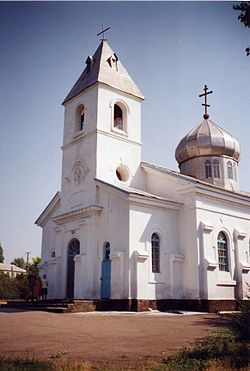Gammalsvenskby


Verbivka (Standard Swedish: Gammalsvenskby, local Swedish dialect: Gammölsvänskbi; literally: "Old Swedish Village"; Ukrainian Старошведське, Staroshveds'ke) is a part of the village Zmiyivka (Ukrainian: Зміївка, Russian: Змеевка) in Kherson Oblast, Ukraine which has a Swedish cultural heritage.
The founding of Gammalsvenskby
The population of Gammalsvenskby traces its origins back to Hiiumaa (Dagö) in present-day Estonia, once a part of the Realm of Sweden. Under the reign of Catherine II of Russia, the Swedish-speaking population left the island in August 1781. With the promise of being granted fertile land, they were relocated to the south of Ukraine, used as colonists in territory conquered from the Ottoman Empire. Some sources label the migration as outright expulsion, others point to the fact that the poor and oppressed serf farmers were given what must have seemed like a generous offer at the time. The outcome, however, was to be disastrous. Many of the around 1,000 villagers died during the march to their new home. Upon arrival, they found no trace of the houses they had been promised would be ready for them. The first year in Ukraine an even larger share of the group lost their lives. According to church records, only 135 people were still alive in March 1783.
Maintaining the Swedish heritage
Three neighbouring villages were founded in the years 1803 to 1805 by German colonists: Schlangendorf, Mühlhausendorf and Klosterdorf. Today, these villages are all part of Zmiyivka. As a consequence of this, the Swedes were outnumbered, and in the following years many of the priests and teachers serving the area were German. This, along with a growing shortage of arable land caused the relations between Gammalsvenskby and the German villages to be rather strained at times.
Although contacts with Sweden were virtually nonexistent for around a century, the people of Gammalsvenskby maintained their traditions and their Lutheran (Church of Sweden) faith. They also kept their old Swedish dialect. At the end of the 19th century, some ties were reestablished. A considerable amount of money was raised in Sweden and Finland to build a Swedish church, St John's parish, which was inaugurated in 1885. Visits from Sweden became rather frequent, and some villagers even subscribed to Swedish newspapers.
The Russian revolution

World War I once again cut off the communication channels. After the Russian revolution, the villagers pleaded for the right to leave the Soviet Union and settle in Sweden, where their case had been adopted by a movement with a nationalist flavour, supported by archbishop Nathan Söderblom. On August 1, 1929, around 900 villagers arrived in Sweden. Just a handful had opted to remain in Gammalsvenskby. Nearly a hundred soon moved on to Canada, a country to which earlier emigrants from Gammalsvenskby had gone. Most of them settled in Manitoba. Some later returned to Sweden.
The majority of the villagers stayed in Sweden, many of them settling in Gotland. Despite their common origins, they were not allowed to stay in a single, common settlement. Considered immigrants in a country in the middle of a severe economic crisis, they were sometimes met with hostility. Soon, some of the villagers started to talk about going back to the Soviet Union. Actively persuaded by the Communist Party of Sweden, the first families left before the end of 1929.
Back in the USSR
In total, around 250 villagers chose to return to the Soviet Union. Together with members of the Communist Party of Sweden, they established a minor collective farm called Svjedkompartija - the Swedish Communist Party.
But life in the Soviet Union turned out to be hard. The famine of 1932-1933 renewed interest in the idea of returning to Sweden - some villagers signed a list stating that they wanted to leave the country. This led to the arrest of 20 people by the secret police, the GPU. Five of them were sent to prison. Several villagers were killed in the Stalinist purge of the following years.
When the German army marched into the village on August 25, 1941, the soldiers were welcomed as liberators. With the retreat of the German army in 1943, the Swedes were evacuated together with the Germans of the area. Many ended up in Krotoschyn in Warthegau in the occupied Poland, and nearly 150 were caught by Soviet authorities at the end of the war and sent to labor camps - Gulags, but were allowed to return to Ukraine as early as 1947. Others managed to go to Sweden or directly back to Gammalsvenskby.
Gammalsvenskby today
After the fall of the Soviet Union, contacts with Sweden have been reestablished. Some economic support has been given by the Church of Sweden and Gotland Municipality. In 1996, Chumak, a Swedish-owned company that produces oil, ketchup and canned food, was established in the nearby town of Kakhovka. Today, the village has 150-200 people who share a Swedish cultural heritage. Only a few of them still speak the Swedish dialect fluently and German is often used instead.

During the German offensive 25 th of Aug 1940, when the villagers met the German army the first time,the 54 men that marched in to the village was from the Scandinavian recruited SS-division Wiking.
See also
External links and further reading
- The Svenskbyborna society in Sweden (in Swedish)
- A comprehensive history of Gammalsvenskby (in English)
- A page about Gammalsvenskby (in Swedish)
- Recent short article on Gammalsvenskby: A Swedish village in Ukraine, in Hidden Europe magazine, May 2006 (Issue 8), pp. 40-43. ISSN 1860-6318. hidden europe (in English)
- Photos from Gammalsvenskby: [1]

